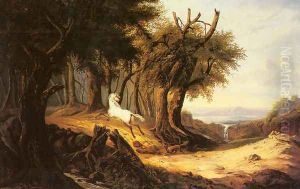F. Hayman Paintings
Francis Hayman was an English painter and illustrator who played a significant role in the British art scene in the 18th century. Born in Exeter in 1708, Hayman began his artistic career as a scene painter for the theatre under the influence of Charles Jervas. He later moved to London, where he became involved with the St. Martin's Lane Academy, a precursor to the Royal Academy.
Hayman was a versatile artist, known for his historical and genre paintings as well as his book illustrations. His historical paintings often depicted scenes from British history, aiming to inculcate a sense of national pride. He was also known for his portraits, which were popular among the gentry and nobility of the time. His work is characterized by a robust, painterly style and a keen ability to capture the character and spirit of his subjects.
In addition to his painting, Hayman was instrumental in the foundation of the Royal Academy of Arts in 1768, serving as one of its founding members. This institution was created to promote the arts in Britain through education and exhibitions, and it continues to be a leading art institution to this day.
Hayman's contributions to book illustration were also significant, particularly his work for Samuel Richardson's novel 'Pamela' and for an edition of Shakespeare's works. These illustrations helped to define the visual culture of the era and influenced the development of narrative illustration in Britain.
Throughout his career, Hayman faced financial difficulties, yet he continued to be an active member of the artistic community until his death in 1776. His legacy includes not only his diverse body of work but also his impact on British art institutions and practices. Despite being less well-known today than some of his contemporaries, Hayman's role in the development of the arts in 18th-century Britain remains an important part of the country's cultural history.
